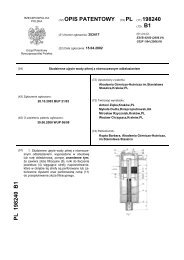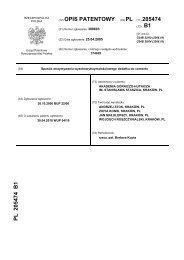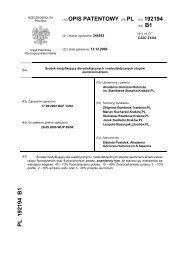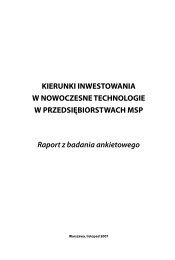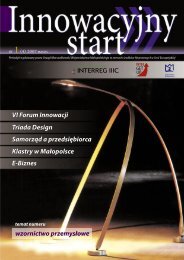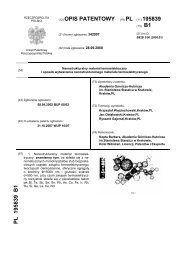Wyd. specjalne/2011 - Regionalny OÅrodek Informacji Patentowej ...
Wyd. specjalne/2011 - Regionalny OÅrodek Informacji Patentowej ...
Wyd. specjalne/2011 - Regionalny OÅrodek Informacji Patentowej ...
- No tags were found...
You also want an ePaper? Increase the reach of your titles
YUMPU automatically turns print PDFs into web optimized ePapers that Google loves.
with an overall impression made by anearlier design. In the directive, similarly asin the text of IPL, it is not specified howbig a distinction in the overall impressionmust be to consider an industrial designto have individual character. A differentapproach was applied in the draftof the directive, where the wording “differssignificantly” was used, which signalledthe intention of setting a high levelof distinction as a condition for claimingindividual character. However, deletionof the specification of the level of the distinctionbetween the designs does notmean reduction of the requirements, asrecital 13 of the preamble to the directiveprovides that the assessment asto whether a design is having an individualcharacter should be based on whetherthe overall impression that a designmakes on an informed user is clearlyin contract with an impression whichis made by the whole of the design.The lack of uniformity in the approachin the text of the directive and in the preamblebrings about interpretational difficultiesin the practice 3 .In principle, judicial decisions of the Polishcourts are in agreement as to whatcriteria should be taken intoconsideration for the assessmentof the individual character of the design.They are the following: 1) criterionof the author’s freedom while workingon the design and 2) criterion of the distinctionin the overall impression 4 . Inthe EU law there is one more criterionwhich points at the nature, characterof a product related to the design, orof industry sector related to it. That criterion,however, is not mentioned in the PolishIPL though it is referred to in recital13 of the preamble to the directive 5 . Itseems that significance of those elementsshould not be left out in the assessmentof the criterion of the author’screative freedom.While deciding whether the conditionof having an individual character is met(Article 104 IPL) a comparison with earlierdisclosed designs should be made.Unlike in case of deciding on the novelty,when making an assessment we shouldnot concentrate on the distinction betweenparticular features of the designswhich are compared. The crucial issueis that the designs should makeon the user a different overall impression,thus an indication is just the overall impressionwhich is gauged. That is preciselywhat was argued in the judgmentof the District Administrative Court of 7May, 2007 6 .The analysis of the distinction betweenan assessment of novelty and individualcharacter of the design was the subjectof consideration of the Board of Appealof the OHIM in its decision of 22 November2006 in the case Daka ResearchInc v Ampel 24Vertriebs-GmbH & Co.KG 7 . The Board stated that the noveltytest is of impartial nature and it is aboutdeciding whether the earlier designand the design in dispute are identical.The main interpretational difficulty liesin the concept “insignificant differences”.However, the individual character testis of more subjective nature as the adjudicativebody should take into considerationthe overall impression a designmakes on an informed user as well asthe author’s creative freedom. It meansthat the less is the freedom due to technicallimitations the less distinction in comparisonwith the earlier design is sufficientin order to meet the requirement of anindividual character 8 .The level of the distinction betweena new design and earlier ones wasthe subject of the discussions leadingto preparatory work for implementationof the directive. The original proposalof the Commission assumed thatthe designs should differ significantly,however later on the word ‘significantly’was deleted, which aimed at loweringthe requirements for protection and atthe same time reducing its scope.In spite of that change, the wordingof recital 13 of the preamble accordingto which the designs should differ clearlywas maintained. However, Article 5of the directive does not indicate the levelof the distinction, and that is why, in viewof the lack of consistency betweenthe preamble and the text of the directive,one explicit interpretation is hardly possible.The idea behind introduction of a prerequisitefor individual character was to seta higher level in comparison with the novelty.During the novelty test, an assessmentof possible insignificant differencesis also made, and that fact influencesan assessment of another condition, i.e.of an individual character, as it shouldfocus on more significant differences. Inview of the above, it should be assumedthat the differences between designsmust be considerable in referenceto a given category of designs.Assessing an overall impression –in the light of the decision of the CancellationDepartment of the OHIM – aninformed user should pay less attentionto the features of functional nature 9 . TheCommission in the draft of the regulation– referring to a prerequisite for individualcharacter – stressed that there is moreprobability that designs of a more functionalnature, where the author’s creativefreedom is limited, are more similar thanin the case of the designs in the creationof which the author enjoys more freedom.It is however, worth emphasizing thatin practice, for an informed user whois not an expert, it is not an easy taskto identify the abovementioned featuresof the design.The scope of the creative freedom is anaspect of the creation of an industrialdesign, which is given special importanceby making it a criterion of the assessmentof an individual character of anindustrial design (Article 104, item 2of IPL, Article 5, item 2 of the directive).The level of the author’s freedom definesthe availability of the means with whichhe can influence the appearance of hiscreation. The idea behind that criterionis making the assessment of the distinctionbetween new and earlier designseasier. The less is the creative freedom,the less distinction is sufficient for obtainingthe protection of an industrial design,and the more is the freedom, the biggershould be the distinction betweennew and earlier designs. In conclusion,the distinction between the mostsimilar designs assessed in the relationto the limitations of the author’s freedomis always a decisive factor.<strong>Wyd</strong>anie <strong>specjalne</strong> KWARTALNIK URZĘDU PATENTOWEGO RP • 55




